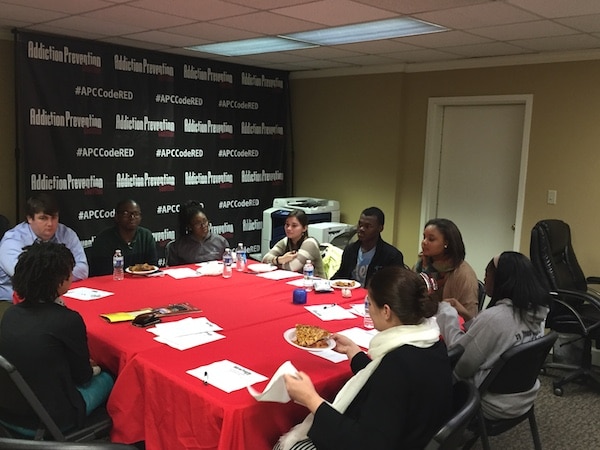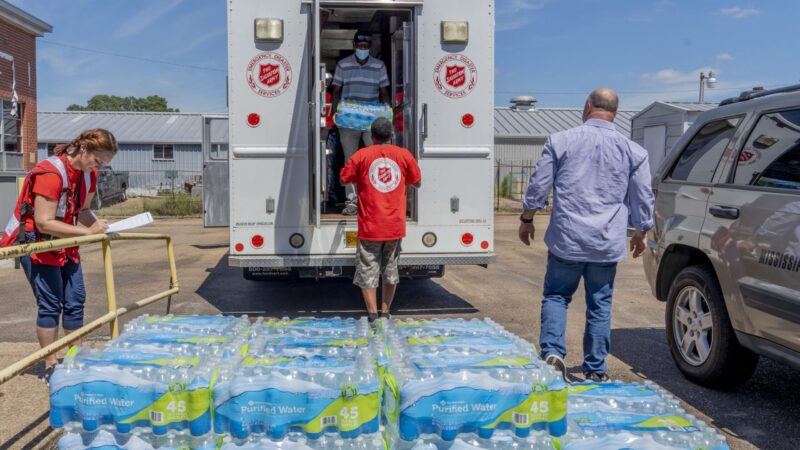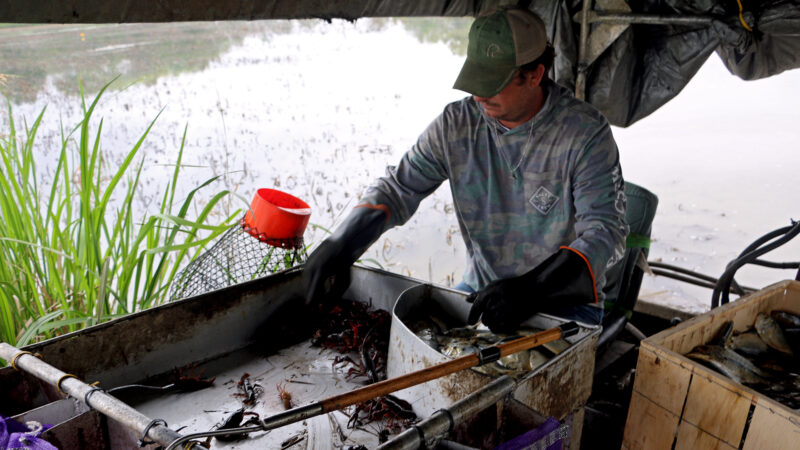Preventing Addiction In Schools
An Addiction Prevention Coalition "YAC" (Youth Advisory Council) meeting. The adults at the table are, clockwise from bottom right, Elizabeth Drennen, Renee Smith, and J. Sandor Cheka III, APC's executive director.
 Birmingham, Ala. — In Part One of WBHM’s five-part series, we heard about how and why heroin use is on the rise in Alabama. Now in Part Two, education reporter Dan Carsen looks at how some young people are trying to slow its spread in their schools. The story starts in a small office just outside downtown Birmingham:
Birmingham, Ala. — In Part One of WBHM’s five-part series, we heard about how and why heroin use is on the rise in Alabama. Now in Part Two, education reporter Dan Carsen looks at how some young people are trying to slow its spread in their schools. The story starts in a small office just outside downtown Birmingham:
A half-dozen high-school students and three adults sit around a table in a cluttered office that might best be described as “nonprofit chic”: posters and bulletin boards on the walls, stacks of papers and brochures everywhere, and of course, pizza. It’s the headquarters of the Addiction Prevention Coalition, and something unusual is about to happen. Elizabeth Drennen, a conservatively dressed middle-class thirty-something, begins speaking.
“For me, it started out with getting hooked on pain pills,” she confides. “I loved the way they made me feel. And from that moment on I was bound and determined to find that same feeling. It was like all of a sudden I felt normal. You know, like … ahhhhh … I can breathe. And so, it got to the point where the painkillers were too hard to find. When somebody offered me the I-V needle, and heroin, I said ‘sure.'”

Drennen’s confession is unusual not because she’s admitting to addiction, not because she doesn’t look like an old stereotype of a user. Her confession is unusual at this meeting because an adult is doing the talking. Unlike old-school drug programs, the Addiction Prevention Coalition’s approach is student-driven. The kids decide how best to tackle the problem. Their approaches are as diverse as the 12 area schools APC serves. And so are their reasons for getting involved.
“I had a father who actually … used drugs, and it touched me,” says Joshua Bibbs, a senior at St. Clair County High. “It just made think ‘hey, maybe there’s other people out there, through your situation you can go and help somebody’ and tell them, like, ‘hey, you’re not alone, I’m here, I can help you.'”
His friend J’La Jenkins, a junior at Hoover’s Spain Park, says kids are mixing codeine with soda to make “dirty Sprite.” That troubles her partly because addictions shortened the lives of both her grandfathers.
“I never really got to have a relationship with them,” she remembers. “And that really hurt me, because, you know, everybody wants to feel like, ‘Hey Paw-Paw!’ And I never got that, so I, I want … I want people I know to live healthy and long lives.”
These students meet at the APC office to compare notes, get strategy ideas, and just talk. But when they’re back in their schools, figuring out how best to get their peers’ attention is up to them individually. Alabama School of Fine Arts senior and APC chapter president Jasmin Revanna has taken some unconventional approaches.
“We did yoga … we did a flash mob actually, so we try to do fun things so people realize we’re not a boring club where people just preach.” She adds, “You don’t have to be on drugs to join the club; you don’t have to know anyone who does it. You just have to want to learn.”

She says she knows of ASFA graduates using heroin, but she’s seen the problem up close only through her APC chapter’s work at The Foundry, a recovery program in Bessemer. Jasmin’s school counselor Dina Marble says staff have seen just a few cases of heroin use in students, but that’s more than they’ve ever seen before, and she wants to keep those numbers small (or zero). She appreciates the prevention coalition’s bottom-up approach:
“They are insightful enough to know that the students are the ones who have a pulse on the community. And the adults in that program are very present in their empowering students to help them get some things done that they might not be able to do by themselves.”
And that’s good, because heroin has been getting cheaper. Though school staff are usually reluctant to go on record, across the state, many say they’re seeing more and more. And it doesn’t matter if you’re in a nice neighborhood. As a matter of fact, recovering addict Brad Blount of well-to-do Vestavia Hills says having money cuts both ways.
“It’s a blessing and also a curse,” he says. “If you give your kid a hundred dollars a week, okay, you go out to a movie and maybe dinner … What’s the rest going to?”

Blount has given talks to hundreds of people in his hometown, which has seen a rise in overdoses, but has also admitted the problem and faced it head on. The Addiction Prevention Coalition, which works against what its leaders call “the conspiracy of silence,” gave Vestavia Hills its first ever Community Impact Award this winter.
So what conclusions can one draw here? One counterintuitive takeaway is that, in a very real way, though it feels strange to say, heroin is a unifier. As students, counselors, judges, and police will tell you, it easily straddles the demographic lines that normally separate us. It also unites people with knowledge of addiction in the sense that it elicits from them basically the same plea to anyone connected with young people: talk honestly and calmly with your kids.
ASFA counselor Marble puts it this way:
“My advice would be just to remain open. Sometimes when we’re very, very close to kids, we feel like we know everything they’re doing, and sometimes they may be involved when they seem like they’re holding everything else together.”
Blount, who’s been on the other side of this issue, also implores, “Be open with your kids. Don’t try to lie to them about the drugs. Don’t try to scare them. Tell the truth.”
APC Prevention Coordinator Renee Smith says too many kids struggling with drug issues tell her the same thing over and over again:
“‘I would love to talk to my parents about this issue, but I’m afraid.’ They really just want real answers.”
Alabama’s racial, ethnic health disparities are ‘more severe’ than other states, report says
Data from the Commonwealth Fund show that the quality of care people receive and their health outcomes worsened because of the COVID-19 pandemic.
What’s your favorite thing about Alabama?
That's the question we put to those at our recent News and Brews community pop-ups at Hop City and Saturn in Birmingham.
Q&A: A former New Orleans police chief says it’s time the U.S. changes its marijuana policy
Ronal Serpas is one of 32 law enforcement leaders who signed a letter sent to President Biden in support of moving marijuana to a Schedule III drug.
How food stamps could play a key role in fixing Jackson’s broken water system
JXN Water's affordability plan aims to raise much-needed revenue while offering discounts to customers in need, but it is currently tied up in court.
Alabama mine cited for federal safety violations since home explosion led to grandfather’s death, grandson’s injuries
Following a home explosion that killed one and critically injured another, residents want to know more about the mine under their community. So far, their questions have largely gone unanswered.
Crawfish prices are finally dropping, but farmers and fishers are still struggling
Last year’s devastating drought in Louisiana killed off large crops of crawfish, leading to a tough season for farmers, fishers and seafood lovers.








